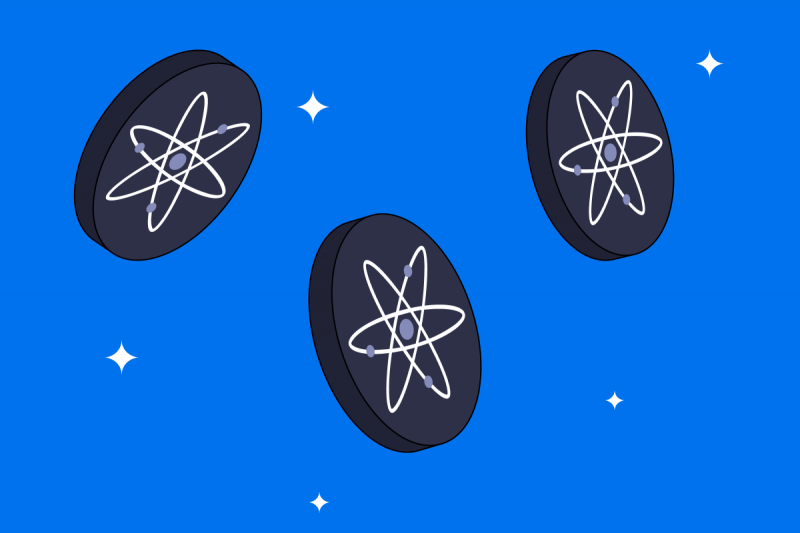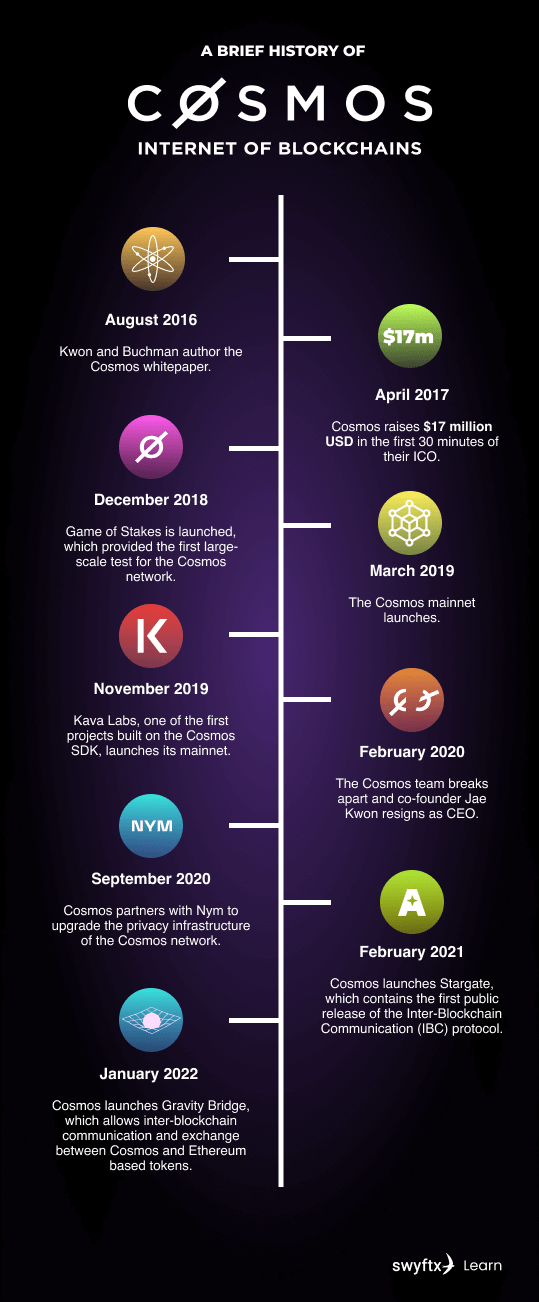
Cosmos (ATOM) is the coin that powers the entire Cosmos ecosystem, which consists of a variety of innovative projects from different spheres such as finance, decentralized exchanges, and cloud computing. This article explains what Cosmos is and provides a brief history for context. It also explores the many elements of the Cosmos ecosystem, how it works, and the essential role that ATOM plays in everything.
What is Cosmos?
Cosmos is a crypto ecosystem that allows multiple parallel blockchains to interact with one another and share data. Billed as the “internet of blockchains” by its founding team, Cosmos aims to create the next version of the internet, one with blockchains at the centre of everything. Even the co-founder of Ethereum, Vitalik Buterin, regards Cosmos as an inspiration for the future of the Ethereum network.
The focus that Cosmos has on customisability and cross-chain interoperability (the ability to access and share data across blockchains) is what differentiates it from many other projects. Unlike many projects that dedicate all of their resources to developing and expanding their own network, Cosmos aims to create a diverse and decentralized ecosystem of interconnected blockchains that can share data and tokens automatically. Cosmos is a bit like a teacher who focuses on educating a class of students, rather than just their own child.
Who founded Cosmos?
Cosmos was founded by developers Jae Kwon and Ethan Buchman, who had previously worked together to create the Tendermint consensus algorithm (which now powers the Cosmos network). The Interchain Foundation (ICF), a Swiss non-profit, that specialises in funding open-source blockchain projects, also helped Kwon and Buchman develop and launch Cosmos.
A brief history of Cosmos

Figure 1 – A brief history of Cosmos
How does Cosmos work?
The Cosmos network consists of three layers:
- Networking – this layer communicates transaction confirmations and other consensus messages with Cosmos hub blockchains.
- Application – this layer keeps the network up to date with the state of transactions and balances of each blockchain.
- Consensus – this layer manages the agreement of nodes on how they add new transactions.
All of these elements work together using Tendermint, a custom consensus mechanism, and an application interface. The Cosmos Hub is powered by the Cosmos network’s native token, ATOM. We will cover zones, the cosmos crypto token (ATOM), and the Cosmos Hub in more depth below.
Key elements of Cosmos
Cosmos Hub
The Cosmos Hub is the main blockchain of the ever-expanding ecosystem of Cosmos. It was the first blockchain to be launched in the ecosystem. Each new blockchain that is created within Cosmos, which is referred to as a “Zone”, is tethered to the Cosmos Hub, which keeps a record of the state of each Zone. The Hub is a Proof of Stake (PoS) blockchain that transfers assets and data between the tethered zones and offers a shared layer of security.
Key Takeaway
The Cosmos Hub is like a mission control centre, and all of the Zones (independent blockchains) are spaceships or satellites that Cosmos Hub communicates with and ensures the safety of.
Cosmos Zones
Zones are custom interoperable blockchains that exist in the Cosmos ecosystem. Each Zone is an application-specific blockchain, for instance, Kava, Terra, or the Secret network, which is tethered to the Cosmos Hub. This allows Zones to communicate and share data with not only the Hub but every other Zone connected to the Hub as well (as long as they have permission). Each Zonecan validate its own transactions, implement custom developments, and mint tokens.

Figure 2 – A visual map of all of the most active Zones in the past seven days.
Did You Know?
Hubs act like routers for different Zones. Cosmos Hub is by far the most popular Hub, however, other Hubs do exist. Anyone can create a new Hub blockchain or Zone. That said, every Zone or Hub also has the power to refuse other connections to their own blockchain, an essential quality control mechanism.
Cosmos SDK
Another feature of the Cosmos ecosystem is the Cosmos software development kit (SDK), which allows developers to create Cosmos blockchains based on the Tendermint consensus algorithm. The Cosmos SDK is a powerful tool for developers because it offers the most common blockchain functionality, such as tokens, governance, and staking. In addition, developers can create plugins to add any extra features they need to their blockchain. In essence, the Cosmos SDK is the skeleton of blockchain, and the plugins are the flesh.
Cosmos ecosystem
The ecosystem of Cosmos consists of a large array of innovative projects with a huge range of different applications. Below we highlight a few of the standout projects that were built using the Cosmos SDK.
Kava
Kava is an innovative decentralized finance (DeFi) protocol and decentralized applications (dApp). Kava utilises multiple cryptocurrencies to allow users to borrow and lend digital assets without the need for a traditional intermediary. Most DeFi projects are built on the Ethereum network, but the Kava developers argue that using Cosmos has allowed them to provide additional functionality. The Kava network’s native token, KAVA, is used to reward users who put up cryptocurrency that is used as collateral for the borrowing and lending system.
Binance Chain
Binance Chain (BC) is a blockchain project that was built using the Cosmos SDK and Tendermint. BC serves as the foundation for Binance DEX, which is a decentralized exchange (DEX). Binance DEX serves as an alternative, decentralized marketplace for using, issuing, and exchanging digital assets.
Terra
Terra is a blockchain network that utilises a suite of algorithmic stablecoins to support DeFi ecosystems. Instead of using fiat as a reserve, Terra’s stablecoins use algorithms to control their supply. Terra stablecoins are essentially backed by the network’s multipurpose native token LUNA. LUNA can be used to participate in governance, pay for network fees, staking, and to peg stablecoins.
Akash
Akash is an innovative project in the world of cloud computing, which is currently dominated by Amazon, Google, and Microsoft. The Akash network provides a fast, efficient, and low-cost alternative for developers to deploy applications, such as websites or decentralized applications (dApps). The Akash network’s native token, AKT, can be used to pay for website or dApp deployments, as well as for staking, and governance.
Important To Remember
These projects are offered only as examples of the diverse range of projects available in the Cosmos ecosystem. They are not intended to be investment advice. Always make sure to do your own research before investing in any new project.
What is the ATOM token?
The ATOM token powers the entire Cosmos ecosystem. It plays a large role in maintaining interoperability between all of the zones in the wider Cosmos network. ATOM tokens can be used for spending, holding, sending, or staking. ATOM is also a governance token, which means that users that stake ATOM are able to vote on network proposals and upgrades. (Voting power is determined by the amount of ATOM staked.)
How to buy ATOM
You can buy Cosmos (ATOM) from most large crypto exchanges. Swyftx is a popular crypto exchange in Australia and New Zealand where users can buy ATOM with low fees and store it in their personal crypto wallet. Swyftx users can also take advantage of our staking feature to stake Cosmos (ATOM) through their personal wallets.
Wrap up
From its inception, Cosmos was billed as the “internet of blockchains”. One blockchain to rule them all. The Cosmos ecosystem is incredibly diverse, ranging from decentralized finance and cloud computing to VPN services and decentralized exchanges. Cosmos has a very ambitious long-term goal: to reshape the internet as we know it, putting blockchains at the centre of everything. The foundations have well and truly been laid, now we have to wait and see how Cosmos evolves and how large its contribution will be to the crypto industry and blockchain technology.
Disclaimer: The information on Swyftx Learn is for general educational purposes only and should not be taken as investment advice, personal recommendation, or an offer of, or solicitation to, buy or sell any assets. It has been prepared without regard to any particular investment objectives or financial situation and does not purport to cover any legal or regulatory requirements. Customers are encouraged to do their own independent research and seek professional advice. Swyftx makes no representation and assumes no liability as to the accuracy or completeness of the content. Any references to past performance are not, and should not be taken as a reliable indicator of future results. Make sure you understand the risks involved in trading before committing any capital. Never risk more than you are prepared to lose. Consider our Terms of Use and Risk Disclosure Statement for more details.
